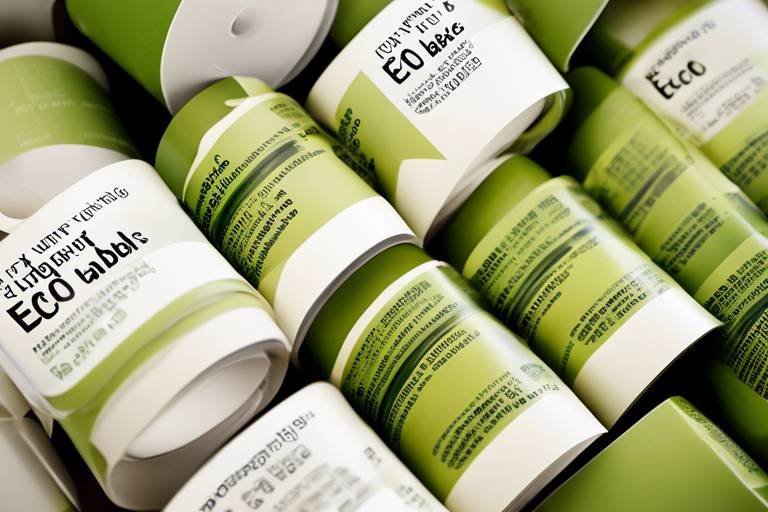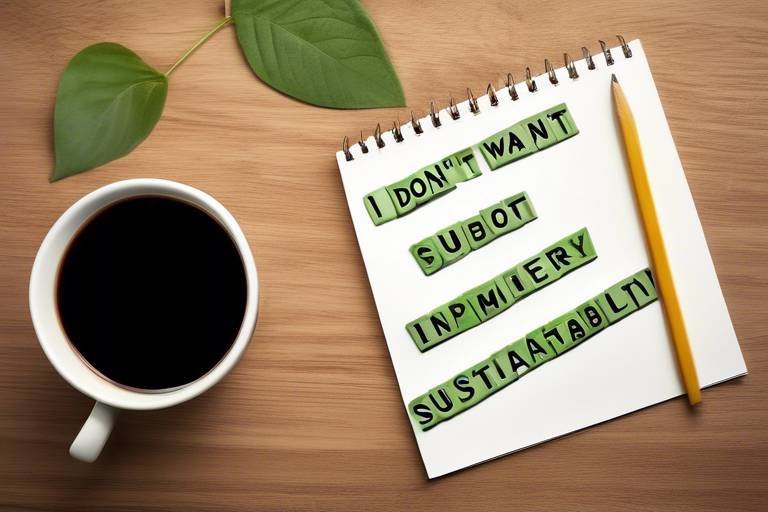How to Choose Eco-Friendly Outdoor Gear
Exploring sustainable options for outdoor enthusiasts who want to minimize their environmental impact without compromising on quality or performance can be an exciting journey. When selecting eco-friendly outdoor gear, one of the key factors to consider is the material selection. Opting for gear made from eco-friendly materials such as recycled polyester, organic cotton, and hemp can significantly reduce the reliance on virgin resources, contributing to a healthier planet.
Moreover, understanding the product lifecycle of outdoor gear is crucial. By assessing factors like durability, repairability, and recyclability, you can ensure that your gear lasts longer and generates minimal waste. Choosing products with a long lifespan and the ability to be repaired can not only benefit the environment but also save you money in the long run.
When looking for eco-friendly outdoor gear, it's essential to research brands and certifications that prioritize sustainability. Brands that hold certifications such as Bluesign, Fair Trade, or B Corp demonstrate their commitment to ethical and eco-conscious practices. By supporting these brands, you can make a positive impact and encourage others to follow suit.
Consider evaluating the energy and water usage associated with the production of outdoor gear. Understanding the environmental footprint of the manufacturing process, including energy consumption and water usage, allows you to make informed decisions that align with your sustainability goals. Opting for gear produced using eco-friendly practices can significantly reduce your carbon footprint.
Another important aspect to consider is the packaging and shipping of outdoor gear. Choosing products with sustainable packaging materials and supporting companies with eco-friendly shipping practices can help reduce single-use plastics and lower carbon emissions. By being mindful of these aspects, you can contribute to a greener future.
Exploring end-of-life options for outdoor gear is also essential in minimizing waste. Look for brands that offer recycling programs, upcycling initiatives, or provide guidance on proper disposal methods. By responsibly managing the disposal of your gear at the end of its usable life, you can prevent it from ending up in landfills and promote a circular economy.
While prioritizing sustainability, it's crucial not to overlook the functionality and performance of outdoor gear. Balancing eco-friendly considerations with the practicality and performance requirements of the gear ensures that you can enjoy your outdoor activities to the fullest while minimizing your environmental impact.
Engaging with the outdoor community and supporting advocacy efforts for sustainable practices in the outdoor industry can also make a significant difference. By actively participating in initiatives that promote eco-friendly gear and practices, you can contribute to positive change and raise awareness about the importance of sustainability in outdoor activities.

Material Selection
Exploring sustainable options for outdoor enthusiasts who want to minimize their environmental impact without compromising on quality or performance.
When it comes to choosing eco-friendly outdoor gear, the material selection plays a crucial role in reducing the environmental footprint. Opting for materials such as recycled polyester, organic cotton, and hemp can significantly decrease the reliance on virgin resources. These materials not only help in conserving natural resources but also contribute to reducing waste generation. By embracing sustainable materials, outdoor enthusiasts can enjoy their adventures while knowing they are making a positive impact on the planet.

Product Lifecycle
Exploring sustainable options for outdoor enthusiasts who want to minimize their environmental impact without compromising on quality or performance.
When it comes to choosing eco-friendly outdoor gear, the product lifecycle plays a crucial role in sustainability. Understanding the durability, repairability, and recyclability of the gear you purchase is essential to ensure longevity and minimize waste generation.
Opting for gear made from materials that are easily recyclable or biodegradable can significantly reduce the environmental impact. Brands that offer repair services or have take-back programs for worn-out gear contribute to a circular economy, extending the lifespan of products and reducing the need for constant replacements.
Additionally, considering the manufacturing process of outdoor gear is vital. Look for brands that prioritize energy-efficient production methods and use water responsibly. By choosing gear from companies that are transparent about their environmental practices, you can make informed decisions that align with your sustainability goals.
Moreover, educating yourself on how to properly care for and maintain your outdoor gear can also enhance its longevity. Simple actions like cleaning and storing gear appropriately can prevent premature wear and tear, ultimately extending its lifespan and reducing the frequency of replacements.
Ultimately, when selecting outdoor gear with a focus on sustainability, evaluating the entire product lifecycle from production to disposal is key. By choosing products that are durable, repairable, and recyclable, you can actively contribute to reducing waste and minimizing your environmental footprint in the outdoor industry.

Brands and Certifications
When it comes to choosing eco-friendly outdoor gear, one crucial aspect to consider is the brands and certifications associated with the products. Opting for outdoor gear brands that prioritize sustainability can make a significant difference in reducing your environmental impact. Look for certifications like Bluesign, Fair Trade, or B Corp, which indicate that the brand follows ethical and eco-conscious practices throughout their production processes.
Brands that hold certifications such as Bluesign ensure that their products are made with environmentally friendly materials and production methods. Bluesign certification focuses on the entire manufacturing process, from raw materials to the final product, guaranteeing that harmful substances are eliminated and resource efficiency is maximized. By choosing gear from Bluesign-certified brands, you can be confident that you are supporting a sustainable and responsible company.
In addition to certifications, it's important to research outdoor gear brands that have a strong commitment to sustainability. These brands often prioritize using recycled materials, reducing waste in their production processes, and supporting environmental initiatives. By aligning yourself with brands that share your values, you can contribute to the movement towards a more sustainable outdoor industry.
When selecting eco-friendly outdoor gear, consider the transparency of the brands regarding their sustainability efforts. Look for companies that openly communicate their environmental initiatives and provide information on their supply chain practices. By supporting brands that are transparent about their sustainability goals and challenges, you can encourage greater accountability and progress within the outdoor gear industry.

Energy and Water Usage
Exploring sustainable options for outdoor enthusiasts who want to minimize their environmental impact without compromising on quality or performance.
When it comes to choosing eco-friendly outdoor gear, considering the energy and water usage during the production process is crucial. Outdoor gear manufacturing often involves significant energy consumption and water usage, impacting the environment. By opting for gear made by brands that prioritize sustainable practices and resource-efficient production methods, you can reduce the overall environmental footprint of your outdoor adventures.

Packaging and Shipping
When it comes to choosing eco-friendly outdoor gear, it's essential to consider not only the materials and construction of the products but also the packaging and shipping practices involved. Packaging and shipping play a significant role in the overall sustainability of outdoor gear, as they directly impact the amount of waste generated and carbon emissions produced throughout the product's lifecycle.
Many outdoor gear brands are now focusing on reducing their environmental footprint by using recyclable or biodegradable materials for packaging. By opting for packaging materials that can be easily recycled or composted, outdoor enthusiasts can minimize the amount of single-use plastics ending up in landfills or oceans.
In addition to sustainable packaging, the shipping practices of outdoor gear companies also play a crucial role in reducing carbon emissions. Choosing companies that prioritize carbon-neutral shipping methods or offset their shipping emissions through environmental initiatives can significantly lower the overall environmental impact of purchasing outdoor gear.
Some outdoor gear brands are even implementing innovative packaging solutions, such as reusable or returnable packaging, to further reduce waste generation. By encouraging customers to return packaging materials for reuse or recycling, these brands are taking proactive steps towards a more circular and sustainable approach to packaging.
Furthermore, considering the distance the products travel during shipping is also important when assessing the environmental impact. Opting for local or regional outdoor gear brands can help reduce the carbon footprint associated with long-distance shipping, as products travel shorter distances to reach consumers.
Ultimately, by paying attention to the packaging and shipping practices of outdoor gear brands, consumers can make more informed and sustainable choices that align with their values of minimizing environmental impact. Choosing eco-friendly outdoor gear goes beyond just the product itself; it encompasses the entire supply chain, from production to delivery, in order to create a more sustainable outdoor industry.

End-of-Life Options
When it comes to the end of its usable life, outdoor gear doesn't have to end up in a landfill. Many companies now offer recycling programs and upcycling initiatives to give gear a second life. Through these initiatives, materials from old gear can be repurposed into new products, reducing waste and promoting a circular economy.
Proper disposal methods are also essential in minimizing the environmental impact of outdoor gear. Some materials used in outdoor gear, such as certain plastics and chemicals, can be harmful if not disposed of correctly. By following guidelines provided by manufacturers or local recycling facilities, outdoor enthusiasts can ensure that their gear is disposed of in an environmentally friendly manner.
Additionally, donating gently used outdoor gear to organizations or individuals in need can extend the life of the products and reduce overall waste. This not only benefits the environment but also supports communities and promotes a culture of sharing and sustainability.

Functionality and Performance
Exploring sustainable options for outdoor enthusiasts who want to minimize their environmental impact without compromising on quality or performance.
When it comes to choosing eco-friendly outdoor gear, it's crucial to strike a balance between sustainability and functionality. While prioritizing environmentally friendly materials and production processes is essential, outdoor gear must also meet the performance requirements of users to ensure practicality and user satisfaction.
Imagine having a backpack made from recycled materials that tear easily on a hiking trip or a water bottle that leaks during a camping adventure. In such scenarios, the gear's eco-friendly credentials may lose their charm if they fail to deliver on performance when needed the most. Therefore, functionality and performance should not be sacrificed in the pursuit of sustainability.
One way to assess the functionality of eco-friendly outdoor gear is to look at the design features and technology incorporated. For example, a jacket made from sustainable materials should still provide adequate insulation and weather resistance to keep you comfortable in various outdoor conditions. Similarly, eco-friendly footwear should offer the necessary support and traction for hiking or climbing activities.
Moreover, performance testing and user reviews can offer valuable insights into how well eco-friendly gear holds up in real-world scenarios. Understanding the durability, waterproofing, breathability, and overall performance of outdoor gear is essential to ensure that it meets your specific outdoor needs while aligning with your sustainability goals.
By considering both functionality and performance alongside eco-friendly attributes, outdoor enthusiasts can make informed decisions that not only benefit the environment but also enhance their outdoor experiences. Remember, sustainable choices can be both environmentally conscious and high-performing, offering the best of both worlds for outdoor adventures.
Stay tuned for the frequently asked questions section that will address common queries related to choosing eco-friendly outdoor gear and making sustainable choices in the outdoor industry.

Community and Advocacy
Exploring sustainable options for outdoor enthusiasts who want to minimize their environmental impact without compromising on quality or performance.
When it comes to choosing eco-friendly outdoor gear, being part of a community that values sustainability can make a significant impact. Engaging with like-minded outdoor enthusiasts not only provides a support system but also opens doors to advocacy efforts that drive positive change in the industry. By sharing knowledge, experiences, and resources within these communities, individuals can collectively push for more sustainable practices.
Advocacy plays a crucial role in promoting eco-conscious choices in the outdoor industry. Supporting organizations that advocate for sustainability and ethical practices can amplify individual efforts. By participating in campaigns, petitions, or events that raise awareness about environmental issues related to outdoor gear production and usage, enthusiasts can contribute to a larger movement towards a greener future.
Moreover, being part of a community that prioritizes sustainability can inspire individuals to make more informed choices when selecting outdoor gear. By sharing reviews, recommendations, and tips on eco-friendly products, outdoor enthusiasts can influence others to opt for environmentally responsible options. This collective effort not only benefits the environment but also fosters a sense of camaraderie among those committed to making a difference.
Frequently Asked Questions
- What are some eco-friendly materials commonly used in outdoor gear?
Common eco-friendly materials used in outdoor gear include recycled polyester, organic cotton, hemp, and bamboo. These materials are sustainable alternatives to traditional synthetic fabrics and help reduce the environmental impact of outdoor gear production.
- How can I ensure the durability of eco-friendly outdoor gear?
To ensure the durability of eco-friendly outdoor gear, look for products that are well-constructed with reinforced stitching, quality zippers, and durable materials. Additionally, following proper care instructions, such as washing in cold water and avoiding harsh chemicals, can help prolong the lifespan of your gear.
- What certifications should I look for when choosing sustainable outdoor gear?
When choosing sustainable outdoor gear, look for certifications such as Bluesign, Fair Trade, or B Corp. These certifications indicate that the brand follows environmentally friendly and socially responsible practices in their production processes, ensuring ethical and eco-conscious choices.
- How can I properly dispose of outdoor gear at the end of its life?
Proper disposal of outdoor gear at the end of its life is essential to minimize landfill waste. Explore recycling programs offered by brands or organizations, consider upcycling initiatives to give your gear a new purpose, or donate usable items to outdoor gear libraries or thrift stores to extend their lifespan.
- What should I consider when balancing eco-friendliness with performance in outdoor gear?
When balancing eco-friendliness with performance in outdoor gear, consider factors such as functionality, durability, and comfort. Look for gear that meets your performance needs while also aligning with your sustainability values, ensuring a practical and environmentally conscious choice.



















